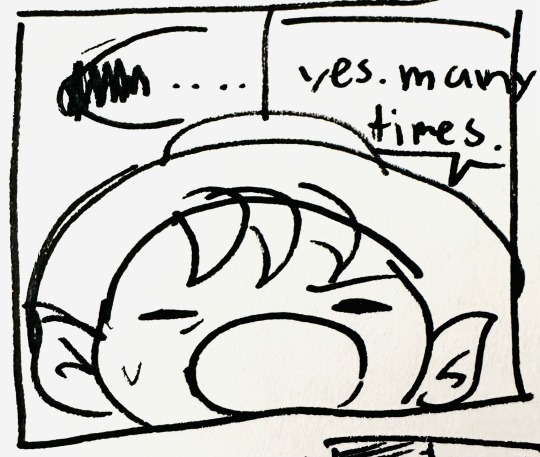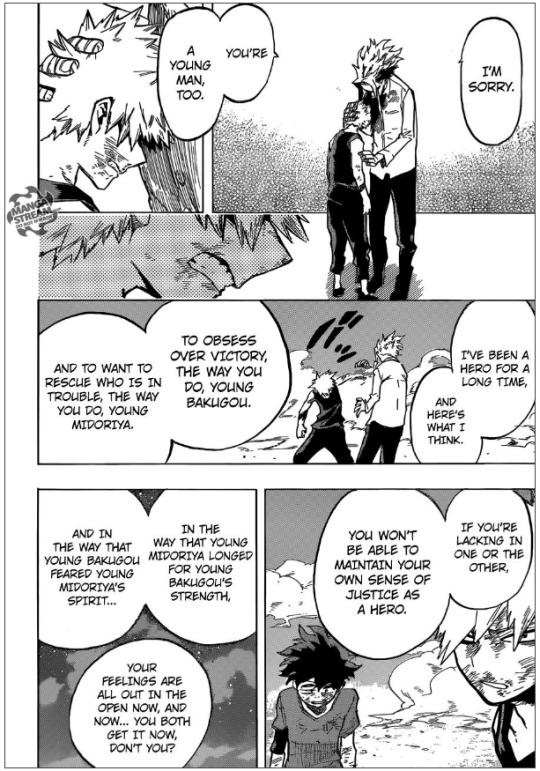#and no the intro sequence with all the series symbols do not count
Text

What if I drew Nintendo High Captainshipping. What if.
#kelperambles#I CURRENTLY AM#doodle is semi-related bc it’s still Nintendo high Olimar but it’s for an ‘episode’ idea#HES SUCH A LOSER I LOVE HIM#I keep saying how I don’t even like Highschool AUS but this series has me in a GRIP despite how heteronormative it feels 😭#if Nintendo high ever includes Olimar or any PIKMIN references I think I would explode happily#and no the intro sequence with all the series symbols do not count#I just want to see Olimar please please please 😭#and make him a loser preferably. even more so.#he’d be best friends with Samus trust me trust me
19 notes
·
View notes
Text
the music theory of katsuki and izuku
my thoughts on the whole ost are here (and as a devout follower of the church of yuki hayashi, i have many) but this is the track i listened to on repeat for an hour and a half yesterday (i’m probably underestimating that) and the one i analyzed a Lot, so i have a lot to say. basically, this track is super cool in a lot of different ways.
also anime-only’s, you might want to avoid this post because spoilers for the end of the season.
and as always, if you want to scream about anime soundtracks with me, send an ask containing your tears and i will probably cry in response
before we begin, here’s the track:
youtube
you’ll want to listen to it before you go any further because your spiritual awakening might get in the way of the nerdy stuff
also: one of my complaints about the soundtrack this season was that we haven’t heard you say run, like, at all, and i think this is why. katsuki and izuku is you say run v3. hallelujah.
part 1: form and orchestration
this song is split up into approximately nine sections:
intro (0:00)
you say run motif 1 (0:26) (listen to you say run here!)
transition (0:38)
bombing king motif 1 (0:51) (listen to bombing king here!)
transition (1:04)
new theme (1:16)
(transition into bombing king motif 2, but it’s only 2 measures so it barely counts) (1:42)
bombing king motif 2 (1:44)
you say run motif 2 (there’s something special about this one but i’ll get to it later) (2:10)
outro (2:39)
the thing i want to point out here is how different the transitions are from the motifs, especially at the beginning.
the motifs have strings and sometimes a choir written in along with the guitar/bass/drums present throughout the song, and they follow a specified chord progression - i.e. in the first you say run motif, the progression is i (c minor), III (e flat major), VI (a flat major), VII (b flat major).
on the other hand, the transitions only have guitar/bass/drums, and there’s no chord progression to be found. in both the transitions, the bass provides a tonic note (C) and stays on that note for eight measures so there can be a distorted guitar riff on top of it. unlike the motifs, the transitions are really dissonant.
this difference becomes more important later in the song, because they eventually disappear. between the first you say run motif and the first bombing king motif, there is an eight-measure transition. between the first bombing king motif and the new theme, there is an eight-measure transition. between the new theme and the second bombing king motif, there is only a two-measure transition, and it’s different than the others because it actually goes somewhere: instead of a dissonant guitar riff, it starts on a Gsus4 chord and resolves to a G major chord, and from there goes home to C minor. Here’s a crappy video of me playing those chords:
youtube
but most importantly, between the second bombing king motif and the second you say run motif, there’s no transition period. at all. it just hits the V chord (G major again, although it might be G7 this time. it really doesn’t matter, it’s a V chord) at the end of bombing king and uses that as the pickup to you say run.
so what does this mean? i’d argue that it’s representative of bakugou and deku starting to understand each other more. the long transition sequences represent the walls between them put up by their respective complexes that prevent them from seeing each other eye to eye. but as those transitions get shorter, they start to see where the other (specifically bakugou, since the story is from deku’s pov) is coming from, coming to a point during deku vs kacchan 2 with the “why was I the reason for all might’s end?” line (anyway if the bombing king strings come in during that line i will be sobbing)
anyway. you know how i was going to say stuff about you say run being special? well,
part 2: chords and leitmotifs
so last night, i wrote out all the chords for this song and i accidentally struck gold, so i’m here to share that gold with all of you.
first, a leitmotif is a fancy word meaning “an associated melodic phrase or figure that accompanies the reappearance of an idea, person, or situation“ (thanks, merriam-webster). it exists because this dude richard wagner wrote a monster four-part epic opera series and needed to keep track of all his shit so the audience wouldn’t get confused, so he wrote hundreds of these little melodies to represent things, characters, symbols and whatever so whenever that character (etc) would come on stage, the audience would recognize them.
film scores especially use leitmotifs a lot (the darth vader theme is one, so is the james bond theme; if there’s a theme from a movie that makes you think of a specific character, it’s probably a leitmotif), and in bnha, there are seven characters who get themes of their own:
deku (you say run)
bakugou (bombing king)
all might (i am here)
todoroki (your power)
iida (ingenium)
all for one (all for one and the power of all for one, but i’ve noticed the latter more and it pops up elsewhere in the ost)
endeavor (endeavor’s power, though this is used for a whole bunch of situations and is really endeavor’s theme in name only).
with the new ost, there are themes for momo, aoyama, overhaul, and mirio, but i haven’t heard any of them in the show yet so i can’t really say what they mean.
technically, leitmotifs are supposed to be short melodies, not whole compositions, but in every one of these themes, there’s one melodic section that stands out. if there’s a Yuki Hayashi String Thing in the song, that’s probably the important part. for reference, you say run’s important melodic line is here, and bombing king’s is here. we can say that these are deku and bakugou’s respective leitmotifs.
funny story, these two important bits are both sampled in katsuki and izuku, one after the other. (which means that there are two Yuki Hayashi String Things in one song and that’s too much power for any mere mortal to comprehend) and it gets better.
SO! on to the fun stuff: chords!
Before you go on, go back and listen to the two important sections of you say run and bombing king again. (if this was in video form, i would just play that again, but unfortunately that is not the case) then listen to the second bombing king and you say run sections in katsuki and izuku. you may notice something off about the second part of the you say run sample. good.
youtube
(the chords in blue will be important later - except the last a flat chord, that was a mistake)
(sorry to those of you who can’t read sheet music, i tried a screen recorder thing but it shit on the sound quality)
anyway, here’s the original version of you say run
youtube
(there are some rhythmic mistakes but ignore them)
and here’s the katsuki and izuku version of you say run. i’ve put changed chords in pink and changed chords that are actually important in blue. see if you notice anything. (you see where i’m going with this)
youtube
yes. yuki hayashi did That. he put the melodic line of you say run over the chords of bombing king. (i suspect it was on purpose) here’s the you say run section in katsuki and izuku one more time just so you can listen to it in all its glory.
so what does this mean thematically?
well, i’m definitely reading too deep into this, but i think it has something to do with this scene from chapter 120:


by having the chords of one theme carrying the melody of the other, they both support each other in a way that couldn’t happen on their own. a melody (even one as iconic as this one) doesn’t pack a punch without a solid harmony behind it, and a chord progression cannot stand out unless it has a melody on top of it pushing it forward and pulling it along.
harmony and melody. winning and rescuing. bakugou and deku. they’re all two sides of the same coin and i’m so fucking glad they managed to mesh them all together like this.
#bnha#boku no hero academia#bakugou katsuki#midoriya izuku#this soundtrack is so good i'm losing my mind#soundtrack rambling#han's soundtrack metas#long post /#meta
544 notes
·
View notes